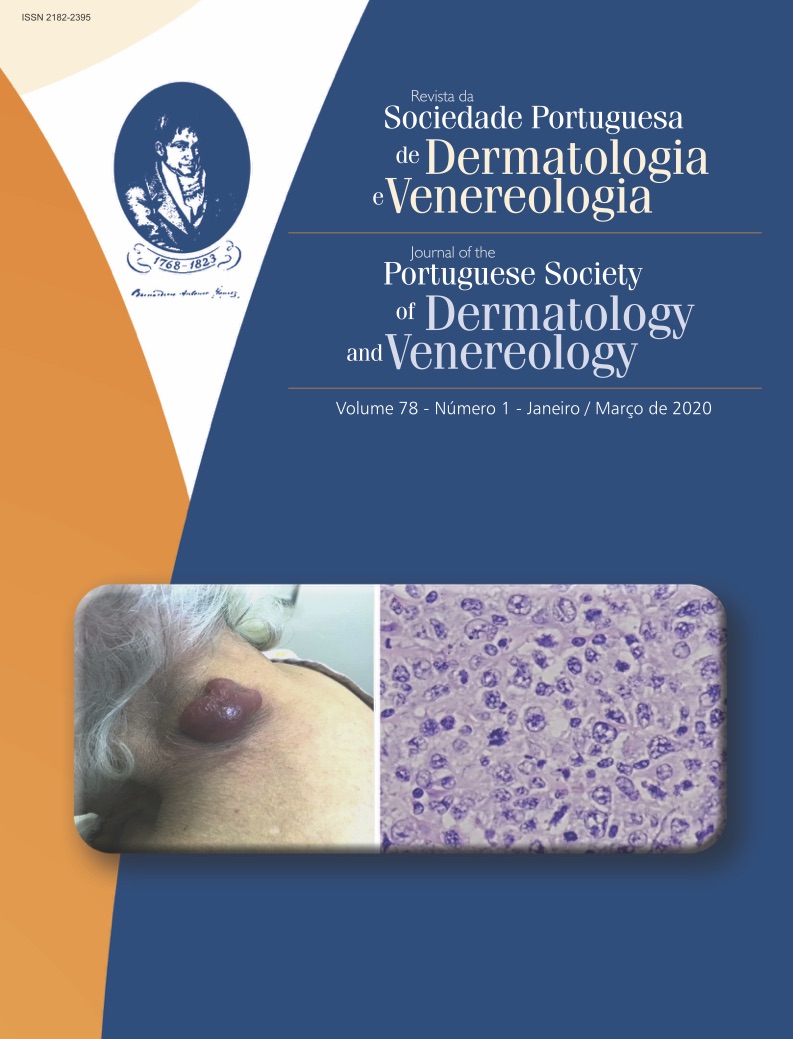A Síndrome de CANDLE
Resumo
A síndrome de CANDLE, chronic atypical neutrophilic dermatosis with lipodystrophy and elevated temperature, é uma doença auto-inflamatória crónica, fisiopatologicamente condicionada pela disfunção intracelular do proteasoma/imunoproteasoma. Esta revisão descreve o reconhecimento da síndrome de CANDLE, os desenvolvimentos na compreensão do seu mecanismo patológico, os antecedentes genéticos e as estratégias terapêuticas emergentes para esta condição.
Downloads
Referências
Torrelo A, Patel S, Colmenero I, Gurbindo D, Lendínez F, Hernández A et al. Chronic atypical neutrophilic dermatosis with lipodystrophy and elevated temperature (CANDLE) syndrome. J Am Acad Dermatology 2010; 62: 489-495.
Liu Y, Ramot Y, Torrelo A, Paller AS, Si N, Babay S et al. Mutations in proteasome subunit β type 8 cause chronic atypical neutrophilic dermatosis with lipodystrophy and elevated temperature with evidence of genetic and phenotypic heterogeneity. Arthritis Rheum 2012; 64: 895-907
McDermott A, Jacks J, Kessler M, Emanuel PD, Gao L. Proteasome-associated autoinflammatory syndromes: advances in pathogeneses, clinical presentations, diagnosis, and management. Int J Dermatol. 2015;54(2):121-9.
Brehm A, Liu Y, Sheikh A, Marrero B, Omoyinmi E, Zhou Q et al. 2015. Additive loss-of-function proteasome subunit mutations in CANDLE/PRAAS patients promote type I IFN production. J. Clin. Invest. 125:4196–4211.
Torrelo A. CANDLE Syndrome As a Paradigm of Proteasome-Related Autoinflammation. Front Immunol. 2017; 9;8:927.
Ferrington DA, Gregerson DS. Immunoproteasomes: structure, function, and antigen presentation. Prog Mol Biol Transl Sci. 2012;109:75–112.
Xirotagaros G, Hernández-Ostiz S, Arostegui JI, Torrelo A. Newly described autoinflammatory diseases in pediatric dermatology. Pediatr Dermatol (2016) 33:602–14
Kitamura A, Maekawa Y, Uehara H, Izumi K, Kawachi I, Nishizawa M, Toyoshima Y,Takahashi H, Standley DM, Tanaka K, Hamazaki J, Murata S, Obara K, Toyoshima I, Yasutomo K. A mutation in the immunoproteasome subunit PSMB8 causes autoinflammation and lipodystrophy in humans. J Clin Invest. 2011 Oct;121(10):4150-60.
Boyadzhiev M, Marinov L, Boyadzhiev V, Iotova V, Aksentijevich I, Hambleton S. Disease course and treatment effects of a JAK inhibitor in a patient with CANDLE syndrome. Pediatr Rheumatol Online J. 2019 May 2;17(1):19
Ramot Y, Czarnowicki T, Maly A, Navon-Elkan P, Zlotogorski A. Chronic atypical neutrophilic dermatosis with lipodystrophy and elevated temperature syndrome: a case report. Pediatr Dermatol 2011; 28: 538-541.
Kluk J, Rustin M, Brogan PA, Omoyinmi E, Rowczenio DM, Willcocks LC et al. Chronic atypical neutrophilic dermatosis with lipodystrophy and elevated temperature syndrome: a report of a novel mutation and review of the literature. Br J Dermatol 2014; 170: 215-217.
Cavalcante MP, Brunelli JB, Miranda CC, Novak GV, Malle L, Aikawa NE et al. CANDLE syndrome: chronic atypical neutrophilic dermatosis with lipodystrophy and elevated temperature-a rare case with a novel mutation. Eur J Pediatr. 2016 May;175(5):735-40.
Al-Mayouf SM, AlSaleem A, AlMutairi N, AlSonbul A, Alzaid T, Alazami AM et al. Monogenic interferonopathies: Phenotypic and genotypic findings of CANDLE syndrome and its overlap with C1q deficient SLE. Int J Rheum Dis. 2018 Jan;21(1):208-213.
Yamazaki-Nakashimada MA, Santos-Chávez EE, de Jesus AA, Rivas-Larrauri F, Guzmán-Martínez MN, Goldbach-Mansky R et al. Systemic Autoimmunity in a Patient With CANDLE Syndrome. J Investig Allergol Clin Immunol. 2019 Feb;29(1):75-76.
Tüfekçi Ö, Bengoa Ş, Karapinar TH, Ataseven EB, İrken G, Ören H. CANDLE syndrome: a recently described autoinflammatory syndrome. J Pediatr Hematol Oncol. 2015 May;37(4):296-9.
Wang H, Das L, Tan Hung Tiong J, Vasanwala RF, Arkachaisri T. CANDLE syndrome: an extended clinical spectrum. Rheumatology (Oxford). 2014 Nov;53(11):2119-20.
Roberts T, Stephen L, Scott C, di Pasquale T, Naser-Eldin A, Chetty M, Shaik S, Lewandowski L, Beighton P. CANDLE Syndrome: orofacial manifestations and dental implications. Head Face Med. 2015 Dec 28;11:38.
Kieselova K, Santiago F, Guiote V, Amado C, Henrique M. Fever, lipodystrophy and cutaneous lesions. Clin Exp Dermatol. 2017 Dec;42(8):939-941.
Torrelo A, Colmenero I, Requena L, Paller AS, Ramot Y, Richard Lee CC et al. Histologic and Immunohistochemical Features of the Skin Lesions in CANDLE Syndrome. Am J Dermatopathol. 2015 Jul;37(7):517-22.
Shwin KW, Lee CR, Goldbach-Mansky R. Dermatologic manifestations of monogenic autoinflammatory diseases. Dermatol Clin (2017) 35:21–38.
Marzano AV, Damiani G, Genovese G, Gattorno M. A dermatologic perspective on autoinflammatory diseases. Clin Exp Rheumatol. 2018 Jan-Feb;36 Suppl 110(1):32-38.
Eleftheriou D, Brogan PA. Genetic interferonopathies: An overview. Best Pract Res Clin Rheumatol. 2017 Aug;31(4):441-459.
Montealegre G, Reinhardt A, Brogan P, et al. Preliminary response to Janus kinase inhibition with baricitinib in chronic atypical neutrophilic dermatosis with lipodystrophy and elevated temperatures (CANDLE) Pediatr Rheumatol. 2015;13(Suppl 1):O31
Sanchez GAM, Reinhardt A, Ramsey S, Wittkowski H, Hashkes PJ, Berkun Y et al. JAK1/2 inhibition with baricitinib in the treatment of autoinflammatory interferonopathies. J Clin Invest. 2018 Jul 2;128(7):3041-3052.
Jabbari A, Dai Z, Xing L, Cerise JE, Ramot Y, Berkun Y et al. Reversal of Alopecia Areata Following Treatment With the JAK1/2 Inhibitor Baricitinib. EBioMedicine. 2015 Feb 26;2(4):351-5.
Todos os artigos desta revista são de acesso aberto sob a licença internacional Creative Commons Attribution-NonCommercial 4.0 (CC BY-NC 4.0).








